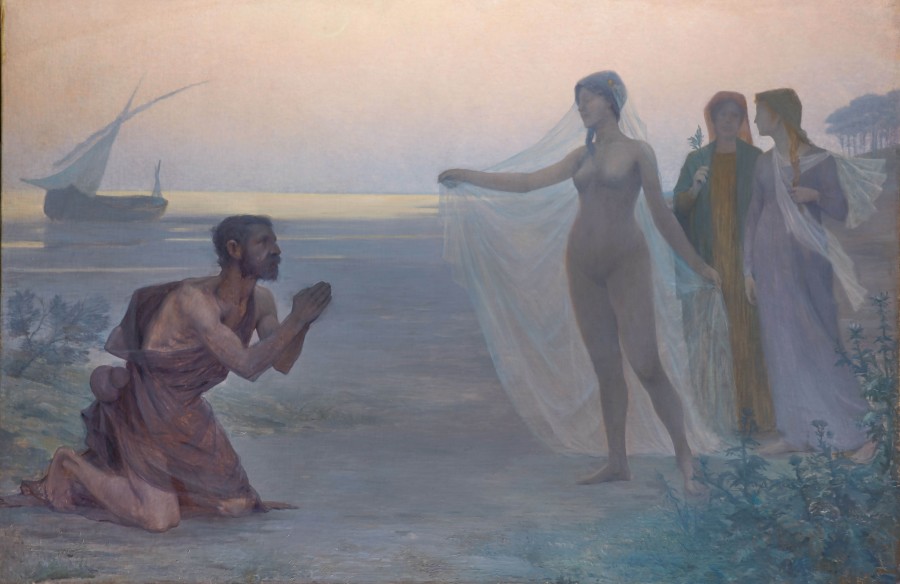Provenance
Private collection France;
Sale, Coutau-Bégarie, Paris, June 4, 1999, no. 121;
Piasa, Paris, June 22, 2001, no. 36;
Private collection, Italy
Exhibitions
Salon de la Société des Artistes Français, Paris, 1900, no. 204.
Brugairolles came from the southern Languedoc region of France and went as a young man to
Paris to study with the academic master Fernand Cormon (1845-1924) at the École des Beaux-
Arts. He began exhibiting at the Salon in 1894, and was primarily a painter of picturesque
landscapes in France and Holland notable for their luminous effects of diffused light on land and
water (figs. 1a-f). Occasionally he depicted rural subjects (fig. 2), but only very rarely did he paint
sensual figural subjects in fantastic colors which recalled his training with Cormon (figs. 3a-b).
The present painting is truly a unique masterpiece in his career and owes a clear debt to the
ethereal, arcadian and mythic subjects of the older painter Pierre Puvis de Chavannes and his
younger symbolist followers like Alphonse Osbert (1857-1939), who was also a student of
Cormon.
The title provided for this painting at the Salon of 1900 was Le Berger et la Mer (The Shepherd
and the Sea), and all educated Frenchmen would have recognized this as referring to one of the
well-known fables of the popular seventeenth-century writer La Fontaine.1 It tells the tale of a
prosperous shepherd who lived by the sea, but who decided to sell his flock and becoming a
merchant sent his fortune off on a ship. However, as he watched, it floundered on the rocks, and he
lost all. Thus, he returned to tending sheep and was able to remake his fortune. One day when by
the shore, he heard the voice of “Madame Ocean” (or in the French original mesdames les Eaux )
inviting him to again send his wealth upon the sea, and he responded, “Address yourself to
someone else, I pray; you shall not get it out of me! I know too well your treachery.” For the
shepherd, having refused to give into the seduction of the sea a second time, the moral poetically
stated is:
This tale’s no fiction, but a fact
Which by experience back’d,
Proves that a single penny,
At present held, and certain.
Is worth five times as many,
Of Hope’s, beyond the curtain;
That one should be content with his condition,
And shut his ears to counsels of ambition,
More faithless than the wreck-strewn sea, and which
Doth thousands beggar where it makes one rich,
Inspires the hope of wealth, in glorious forms,
And blasts the same with piracy and storms.2
Although he had adapted this fable from Aesop, La Fontaine used it as a commentary on the
foolish investment in the then popular speculative maritime Compagnie des Indes. In both the
early illustrated versions of La Fontaine’s Fables (figs. 4a-b) and in the most famous nineteenthcentury
treatments of the fable by Gustave Doré (figs. 5a-b), the lonely shepherd is shown
surrounded by his flock on shore contemplating the sea and the floundering ship. Such images
could well have been the inspiration for Brugairolles rural painting (fig. 2). However, the
inventive caricaturist and illustrator J. J. Grandville (1803-1847), in an 1838 version of the Fables
that was then reprinted several times, treated the story quite differently, showing the sea
personified by a lovely aquatic female figure, a mermaid or siren. (fig. 6).3 Inspired by this
model, Brugairolles incarnates this temptation of “Madame Sea” in the form of a trio of
seductresses (perhaps evoking memories of the Three Graces and the Three Fates). In his
inventive, poetic fantasy Brugairolles depicts a touchingly evocative scene. Set on the sea shore
and bathed in a pinkish-purple haze, the humble shepherd (without a sheep in sight) seems to
invoke the Venus-like “Madame Sea” draped in a large, transparent veil to grant the vessel in the
background safe passage, but to leave him alone. In a reversal of Grandville’s composition, it is
she, rather than the shepherd, who extends her arm. She is accompanied by two more fully clothed
attendants. At their feet grow bramble bushes, perhaps symbolic of the nefarious and capricious
ways of these sea beings.
The prayerful, kneeling figure of the shepherd in this painting immediately brings to mind Puvis
de Chavannes’s famous Poor Fisherman of 1881 (fig. 7a); while the three insubstantial ladies
remind one of the figures in that same master’s 1872 Hope (fig. 7b), which is also set on a seaside
shore. The sea shore is also the setting for many of Osbert’s contemporary fanciful scenes (figs.
8a-b). Nevertheless, Brugairolles has been able to create from his multiple sources a most original
haunting vision, a true triumph of fin-de-siècle Symbolism.
The painting is still in its original frame of wood and gilded stucco decorated with wreaths of oak
leaf ribbons.
